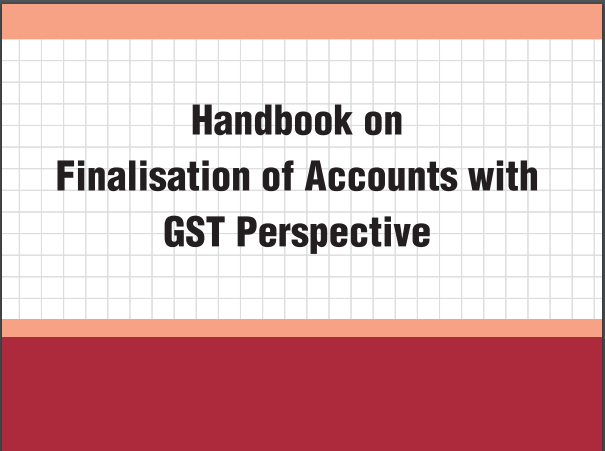Handbook on Finalisation of Accounts with GST Perspective: ICAI
Table of Contents
- Handbook on Finalisation of Accounts with GST Perspective: ICAI
- Chapter 1 Introduction
- 1.0 Finalisation of Accounts
- 1.1 Financial Statements
- 1.2 Notes to Financial Statements
- 1.3 Audit of Financial Statements
- 1.4 Impact of GST law on finalization of Financial Statements
- Read & Download the full Copy in pdf:
Handbook on Finalisation of Accounts with GST Perspective: ICAI
Chapter 1 Introduction
1.0 Finalisation of Accounts
The term ‘Finalisation of Accounts’ refers to the process of planning and control of activities relating to the preparation of the Financial Statements of a business entity.
There must exist a well-defined system to ensure, (a) timely preparation of the Financial Statements, (b) compliance with the various statutes applicable to the entity, and (c) that the Financial Statements represent a true & fair view of the financial status of the entity.
Related Topic:
Important audit checks: Balance sheet
The procedure must encompass all the financial activities conducted or entered into, during the financial year of the business entity.
Related Topic:
Tax Audit checklist Issued by ICAI
1.1 Financial Statements
Financial Statements are formal written records of the financial activities and position of a business entity. These statements are the main source of information for various stakeholders regarding the profitability and financial position of a business. As major decisions by stakeholders having a financial impact are taken based on the Financial Statements, it is imperative that they must present a true and fair view of the financial position. To ensure the same, auditing of these Financial Statements has been largely mandated by various statutes.
Financial Statements normally comprise of-
(a) The statement of financial position (also known as the Balance Sheet) presents the financial position of the entity as on a given date.
(b) The income statement (also known as the Profit & Loss Account) discloses the entity’s financial performance over a specified period.
(c) The Cash Flow Statement depicts the movement of cash and bank balances over a specified period.
(d) Statement of Changes in Equity (also known as the statement of retained earnings) depicts the movement of owners’ equity over a period of time.
While the statements mentioned in (a) & (b) above are to be prepared by all business entities, the Cash Flow Statement and Statement of Changes in Equity are mandated only for specified organizations.
Related Topic:
Points to consider for books finalisation
1.2 Notes to Financial Statements
Any explanatory note annexed to or forming part of, any document referred to in (a) to (d) above will also form part of Financial Statements as per section 2(40) of the Companies Act, 2013.
Reference is invited to Paragraph 8 of SA 700 (Revised) – “Forming an Opinion and Reporting on Financial Statements”, set out below:
“Reference to “financial statements” in this SA means “a complete set of general-purpose financial statements, including the related notes.” The related notes ordinarily comprise a summary of significant accounting policies and other explanatory information and any other information required to be included as part of the financial statements by the laws and regulations governing the entity.”
Attention is also invited to the following paragraphs of the Preface to the Statements of Accounting Standards-
“Para 3.4 The term ‘General Purpose Financial Statements’ includes a balance sheet, statement of profit and loss, a cash flow statement (wherever applicable) and statements and explanatory notes which form a part thereof, issued for the use of various stakeholders, Governments and their agencies and the public. References to financial statements in this Preface and in the Standards issued from time to time will be construed to refer to General Purpose Financial Statements.”
“Para 6.1 The Accounting Standards will be mandatory from the respective date(s) mentioned in the Accounting Standard(s). The mandatory status of an Accounting Standard implies that while discharging their attest functions, it will be the duty of the members of the Institute to examine whether the Accounting Standard has complied within the presentation of financial statements covered by their audit.
In the event of any deviation from the Accounting Standard, it will be their duty to make adequate disclosures in their audit reports so that the users of financial statements may be aware of such deviation”.
From a reading of the above-mentioned Paragraphs, it is clear that a complete set of Financial Statements should include related notes even in the case of non-corporates. It is imperative that an auditor engaged in attesting Financial Statements must ensure that explanatory notes are available and made an integral part of the same. Preparation of the notes is the responsibility of the auditee.
1.3 Audit of Financial Statements
The audit is mandatory for all entities registered under the Companies Act, 2013. In the case of non-corporate entities, even if the audit of their accounts has not been mandated by the statutes governing them, the taxation Acts such as the Income Tax Act, 1961 and the Central Goods and Services Tax Act, 2017 have made audit mandatory for business entities having gross turnover/ receipts beyond a specified limit. Thus, Financial Statements are invariably audited by public accountants and or Government Regulators to ensure accuracy and for tax, financing, or investment purposes.
1.4 Impact of GST law on finalization of Financial Statements
The primary objectives of an auditor is to (a) obtain reasonable assurance as to whether the Financial Statements, as a whole, are free from material misstatement, whether due to fraud or error; and (b) to ensure that the Financial Statements give a true and fair view in conformity with the accounting principles generally accepted in India, of the state of affairs of the entity as at the date of closing of accounts, of its profit/ loss and other comprehensive income, consolidated changes in equity (if applicable) and cash flows for the year/ period then ended.
To achieve the above-stated objective, it is imperative that an auditor should check for compliance with GST law and regulations.
Section 35(5) of CGST Act, 2017 states that every registered person whose turnover during a financial year exceeds the prescribed limit, shall get his accounts audited by a Chartered Accountant or a Cost Accountant and shall submit a copy of the audited annual accounts, the reconciliation statement under sub-section (2) of section 44 and such other documents in such form and manner as may be prescribed. The Proviso to this sub-section excludes from the purview of audit, any Department of the Central Government or a State Government or a local authority, whose books of accounts are subject to audit by the C&AG of India or by an auditor appointed for auditing the accounts of local authorities under any law for the time being in force.
Read & Download the full Copy in pdf:

 ConsultEase Administrator
ConsultEase Administrator
Consultant
Faridabad, India
As a Consultease Administrator, I'm responsible for the smooth administration of our portal. Reach out to me in case you need help.







